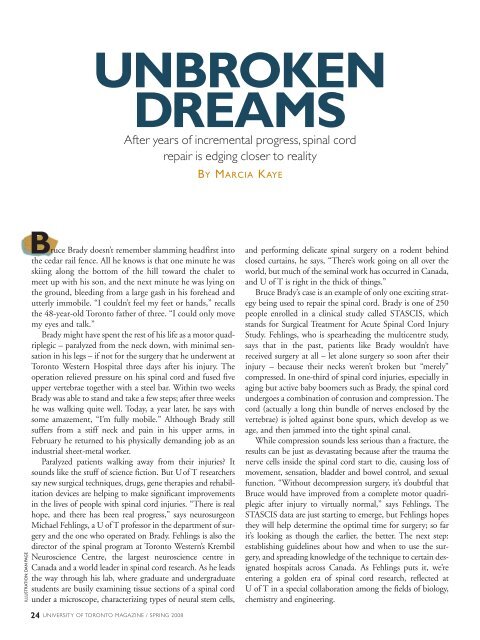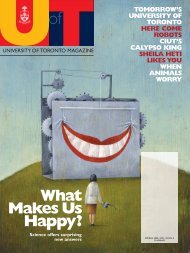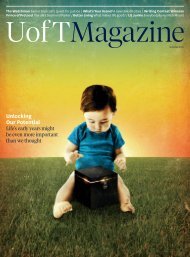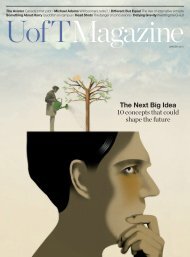20 MB - University of Toronto Magazine
20 MB - University of Toronto Magazine
20 MB - University of Toronto Magazine
- No tags were found...
You also want an ePaper? Increase the reach of your titles
YUMPU automatically turns print PDFs into web optimized ePapers that Google loves.
UNBROKENDREAMSAfter years <strong>of</strong> incremental progress, spinal cordrepair is edging closer to realityBY MARCIA KAYEILLUSTRATION: DAN PAGEBruce Brady doesn’t remember slamming headfirst intothe cedar rail fence. All he knows is that one minute he wasskiing along the bottom <strong>of</strong> the hill toward the chalet tomeet up with his son, and the next minute he was lying onthe ground, bleeding from a large gash in his forehead andutterly immobile. “I couldn’t feel my feet or hands,” recallsthe 48-year-old <strong>Toronto</strong> father <strong>of</strong> three. “I could only movemy eyes and talk.”Brady might have spent the rest <strong>of</strong> his life as a motor quadriplegic– paralyzed from the neck down, with minimal sensationin his legs – if not for the surgery that he underwent at<strong>Toronto</strong> Western Hospital three days after his injury. Theoperation relieved pressure on his spinal cord and fused fiveupper vertebrae together with a steel bar. Within two weeksBrady was able to stand and take a few steps; after three weekshe was walking quite well. Today, a year later, he says withsome amazement, “I’m fully mobile.” Although Brady stillsuffers from a stiff neck and pain in his upper arms, inFebruary he returned to his physically demanding job as anindustrial sheet-metal worker.Paralyzed patients walking away from their injuries? Itsounds like the stuff <strong>of</strong> science fiction. But U<strong>of</strong> T researcherssay new surgical techniques, drugs, gene therapies and rehabilitationdevices are helping to make significant improvementsin the lives <strong>of</strong> people with spinal cord injuries. “There is realhope, and there has been real progress,” says neurosurgeonMichael Fehlings, a U <strong>of</strong> T pr<strong>of</strong>essor in the department <strong>of</strong> surgeryand the one who operated on Brady. Fehlings is also thedirector <strong>of</strong> the spinal program at <strong>Toronto</strong> Western’s KrembilNeuroscience Centre, the largest neuroscience centre inCanada and a world leader in spinal cord research. As he leadsthe way through his lab, where graduate and undergraduatestudents are busily examining tissue sections <strong>of</strong> a spinal cordunder a microscope, characterizing types <strong>of</strong> neural stem cells,and performing delicate spinal surgery on a rodent behindclosed curtains, he says, “There’s work going on all over theworld, but much <strong>of</strong> the seminal work has occurred in Canada,and U <strong>of</strong> T is right in the thick <strong>of</strong> things.”Bruce Brady’s case is an example <strong>of</strong> only one exciting strategybeing used to repair the spinal cord. Brady is one <strong>of</strong> 250people enrolled in a clinical study called STASCIS, whichstands for Surgical Treatment for Acute Spinal Cord InjuryStudy. Fehlings, who is spearheading the multicentre study,says that in the past, patients like Brady wouldn’t havereceived surgery at all – let alone surgery so soon after theirinjury – because their necks weren’t broken but “merely”compressed. In one-third <strong>of</strong> spinal cord injuries, especially inaging but active baby boomers such as Brady, the spinal cordundergoes a combination <strong>of</strong> contusion and compression. Thecord (actually a long thin bundle <strong>of</strong> nerves enclosed by thevertebrae) is jolted against bone spurs, which develop as weage, and then jammed into the tight spinal canal.While compression sounds less serious than a fracture, theresults can be just as devastating because after the trauma thenerve cells inside the spinal cord start to die, causing loss <strong>of</strong>movement, sensation, bladder and bowel control, and sexualfunction. “Without decompression surgery, it’s doubtful thatBruce would have improved from a complete motor quadriplegicafter injury to virtually normal,” says Fehlings. TheSTASCIS data are just starting to emerge, but Fehlings hopesthey will help determine the optimal time for surgery; so farit’s looking as though the earlier, the better. The next step:establishing guidelines about how and when to use the surgery,and spreading knowledge <strong>of</strong> the technique to certain designatedhospitals across Canada. As Fehlings puts it, we’reentering a golden era <strong>of</strong> spinal cord research, reflected atU <strong>of</strong> T in a special collaboration among the fields <strong>of</strong> biology,chemistry and engineering.24 UNIVERSITY OF TORONTO MAGAZINE / SPRING <strong>20</strong>08
















